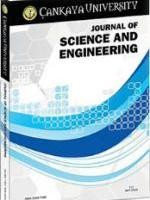The Research and Design of Multi Relays in Cooperative Communication System Based on Polar Codes
The Research and Design of Multi Relays in Cooperative Communication System Based on Polar Codes
Polar codes, linear block code, cooperative coding, BER FER, SC.,
___
- [1] E. Arıkan, “Channel polarization: A method for constructing capacity- achieving codes for symmetric binary-input memoryless channels,” IEEE Transactions on Information Theory, vol. 55, no. 7, pp. 3051–3073, 2009.
- [2] M. Andersson, V. Rathi, R. Thobaben, J. Kliewer, and M. Skoglund, “Nested polar codes for wiretap and relay channels,” IEEE Communications Letters, vol. 14, no. 8, pp. 752-754, 2010.
- [3] H. Eran and S. Shlomo, “Secrecy-achieving polar-coding for binary- input memoryless symmetric wire-tap channels,” arxiv.org/abs/1005.2759/ (accessed 08.06.2018).
- [4] A. Eslami and H. Pishro-Nik, “A practical approach to polar codes,” IEEE International Symposium on Information Theory (ISIT), pp. 16-20, 2011.
- [5] M. Andersoon, V. Rathi, and R. Thobaben, “Nested Polar Codes for wiretap and relay channels,” IEEE Communications Letters, vol. 14, no. 8, pp. 752-754, 2010.
- [6] R. Blasco-Serrano, R. Thobaben, M. Andersson, V. Rathi, and M. Skoglund, “Polar codes for cooperative Relaying,” IEEE Transactions on Wireless Communications, vol. 60, no. 11, pp. 3263-3273, 2012.
- [7] R. Liu, “Cooperative communications and networking,” Beijing: Publishing House of Electronics Industry, 2010.
- [8] E. C. van der Meulen, “Three-terminal communication channels,” Advances in Applied Probability, vol. 3, pp. 120–154, 1971.
- [9] R. Lin, P. A. Martin, and D. P. Taylor, “Approximate Gaussian density evolution-based analysis of distributed and adaptive turbo codes,” IEEE Transaction Communications, vol. 60, no. 8, pp. 2156–2166, 2012.
- [10] B. Zhang, H. Chen, M. El-Hajjar, and L. Hanzo, “Distributed multiple-component turbo codes for cooperative hybrid ARQ,” IEEE Signal Processing Letters. vol. 20, no. 6, pp. 599–602, 2013.
- [11] P. Razaghi, and W. Yu, “Bilayer low-density parity-check codes for decode-and-forward in relay channels,” IEEE Transactions on Information Theory, vol. 53, no. 10, pp. 3723–3739, 2007.
- [12] M. Andersson, V. Rathi, R. Thobaben, J. Kliewer, and M. Skoglund, “Nested polar codes for wiretap and relay channels,” IEEE Communications Letters, vol. 14, no. 8, pp. 752–754, 2010.
- [13] R. Blasco-Serrano, R. Thobaben, M, Andersson, “Polar codes for cooperative relaying,” IEEE Transaction Communications, vol. 60, no. 11, pp. 3263–3273, 2012.
- [14] A. Bravo-Santos, “Polar codes for Gaussian degraded relay channels,” IEEE Communications Letters, vol. 17, no. 2, pp. 365–368, 2013.
- [15] Q. Zhan, M. Du, Y. Wang, and F. Zhou, “Half-duplex relay systems based on polar codes,” IET Communications, vol. 8, no. 4, pp. 433–440, 2014.
- [16] E. Arkan, “A performance comparison of polar codes and reed-muller codes,” IEEE Communications Letters, vol. 12, no. 6, pp. 447-449, 2008.
- [17] O. Gazi, “Polar Codes a Non-Trivial Approach to Channel Coding,” Springer Topics in Signal Processing, vol. 15, pp. 58-72, 2018.
- [18] K. Niu, and K. S. Chen, “Decoding of Polar Codes,” Electronics Letters, vol. 48, no.12, pp. 695-697, 2012
- Yayın Aralığı: Yılda 2 Sayı
- Başlangıç: 2009
- Yayıncı: Çankaya Üniversitesi
Numerical Range of Left Invariant Lorentzian Metrics on the Heisenberg Group H₃ of Dimension Three
Derkaoui RAFİK, Abderrahmane SMAIL
The Research and Design of Multi Relays in Cooperative Communication System Based on Polar Codes
Ali Sameer Hadi HADI, Orhan GAZİ
A Fifth-Order Hybrid Block Integrator for Third-Order Initial Value Problems
Rotımı FOLARANMI, Tolulppe LATUNDE, Abayomi AYOADE
Fast Calculation of Polar Code Bits and Frozen-Bit Locations
Djilali BEKAİ, Benali ABDELKADER, Hakem ALI
Riemann Solutions (LCS)n-Manifolds Admitting Different Semi-Symmetric Structures
